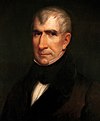
Franklinton is a neighborhood in Columbus, Ohio, just west of its downtown. Settled in 1797, Franklinton is the first American settlement in Franklin County, and was the county seat until 1824. As the city of Columbus grew, the city annexed and incorporated the existing settlement in 1859. Franklinton is bordered by the Scioto River on the north and east, Harmon Avenue on the east, Stimmel Road and Greenlawn Avenue on the south, and Interstate 70 on the west. Its main thoroughfare is West Broad Street, one of the city's two main roads.
Harrison House may refer to:
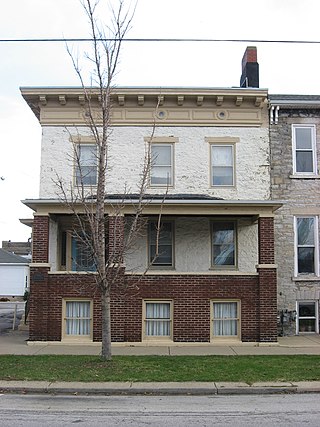
The Eleutheros Cooke House at 410 Columbus Avenue in Sandusky, Ohio is the oldest surviving house in Sandusky. It is a Greek Revival style house that was built in 1827 by Eleutheros Cooke, one of the first settlers in the area and its first lawyer. The original front porch of the house saw General William Henry Harrison receive a flag from the women of Sandusky, in 1835.

The Columbus Foundation is a nonprofit charitable organization in Columbus, Ohio, founded in 1943.

Richards, McCarty & Bulford was an American architectural firm. The General Services Administration has called the firm the "preeminent" architectural firm of the city of Columbus, Ohio. A number of the firm's works are listed on the National Register of Historic Places.
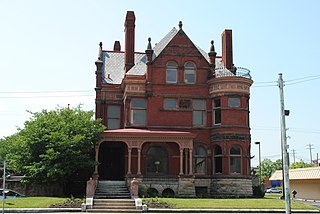
The W. H. Jones Mansion was built in 1889 at 731 East Broad Street, Columbus, Ohio as the residence of dry goods store owner William H. Jones and his wife Josephine. The original cost to build it was $11,250. He lived there until 1923. Jones modelled the house after another mansion in Barnesville, Ohio. The Olde Towne East Neighborhood Association successfully prevented it from being demolished to make way for a Long John Silver's restaurant. The home is an example of Queen Anne style architecture, with a corner turret, third story ballroom and a carriage house in the rear. Its foundation is high ashlar stone, its roof is slate, and the main body of the building is made of red pressed brick.

The Toledo and Ohio Central Railroad Station, today named Station 67, is a union meeting space and event hall located in Franklinton, near Downtown Columbus, Ohio. Built by the Toledo and Ohio Central Railroad from 1895 to 1896, it served as a passenger station until 1930. It served as an office and shelter for Volunteers of America from 1931 to 2003, and has been the headquarters of International Association of Fire Fighters Local 67, a firefighters' union, since 2007. The building was placed on the National Register of Historic Places in 1973. During its history, the building has experienced fires and floods, though its relatively few owners have each made repairs and renovations to preserve the building's integrity. The building is the last remaining train station in Columbus.

Engine House No. 6, also known as the East Franklinton Engine House, is a former Columbus Fire Department station in the East Franklinton neighborhood of Columbus, Ohio. The building was constructed in 1892, designed in the Romanesque Revival style by John Flynn. The station was decommissioned in 1966, and served as an electronics store from 1975 to 2014. It was listed on the National Register of Historic Places in 2016, accompanying planned renovations. The station has been planned to be sold since about 2016, originally to the Columbus Historical Society and Heritage Ohio, though the latter organization now plans to move to the Ohio History Center. The historical society acquired the building in November 2021, and is restoring it with plans to turn it into the city's first permanent local history museum.
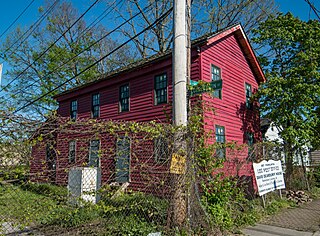
The Franklinton Post Office is a historic building in the Franklinton neighborhood of Columbus, Ohio. It was listed on the National Register of Historic Places in 1973. Also known as the David Deardurff House, it was built of hand-hewed logs by Deardurff in 1807. The two-story house sits on a limestone foundation. It is the oldest building in Columbus still on its original foundation. The building is on Gift Street, an area owned by Franklinton founder Lucas Sullivant, given to early settlers. The first post office in Franklinton was established here.

The Downtown YMCA is a historic YMCA building in Downtown Columbus, Ohio. It is the largest YMCA resident facility in the United States. It was listed on the National Register of Historic Places in 1993. The seven-story building was designed in the Jacobethan Revival and Late Gothic Revival styles by Walter F. Shattuck.

The Columbus Civic Center is a civic center, a collection of government buildings, museums, and open park space in Downtown Columbus, Ohio. The site is located along the Scioto Mile recreation area and historically was directly on the banks of the Scioto River.
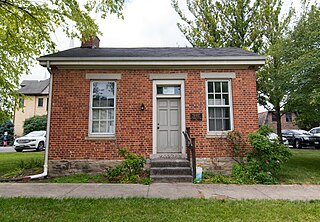
The Sullivant Land Office is a historic building in the East Franklinton neighborhood of Columbus, Ohio. It was listed on the National Register of Historic Places in 1973 and the Columbus Register of Historic Properties, along with the Gen. William Henry Harrison Headquarters, in 1985. The small brick building was built c. 1822. Its original use was as a single-room real estate office, although it was later expanded. At the time of construction, Lucas Sullivant was selling and giving away pieces of land, and Franklinton became the county seat of Franklin County. The building is the only remaining structure associated with Lucas Sullivant in the Franklinton area. In the early 1980s, the Columbus Recreation and Parks Department moved the building from its original location at 714 W. Gay St. to 13 N Gift St., behind the William Henry Harrison house. The move was prompted because the building was endangered in its original location, with vandalism, deterioration, and plans to create a parking lot for a car dealership on the site.

The Lubal Manufacturing & Distributing Company buildings are a set of two industrial buildings in the Franklinton neighborhood of Columbus, Ohio. The site was listed on the Columbus Register of Historic Properties in 2015 and the National Register of Historic Places in 2016. The buildings include 373 West Rich Street, built c. 1900, and 375 West Rich Street, built c. 1911. With much of the original materials intact, the buildings are few remaining that demonstrate Franklinton's early industrial and commercial history.

The Jefferson Avenue Historic District is a historic district in Downtown Columbus, Ohio. The site was listed on the National Register of Historic Places in 1982 and the Columbus Register of Historic Properties in 1983. The site includes approximately 12 buildings regarded for their history and architecture. It is one of few remaining residential neighborhoods downtown. It includes the Thurber House, formerly home to cartoonist and author James Thurber, and the headquarters building of the Columbus Landmarks Foundation. The boundaries of the district vary slightly between the two registers the district was entered in.
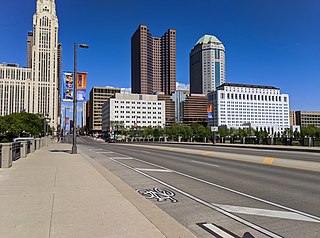
Broad Street is a major thoroughfare in Central Ohio, predominantly in Franklin County and Columbus. It stretches east from West Jefferson at Little Darby Creek to Pataskala. The street is considered one of Columbus's two main roads, along with High Street.

The Columbus Historical Society (CHS) is the historical society for Columbus, Ohio, chronicling the city's history. The society office and museum building is located in the Franklinton neighborhood. In 2020, the Columbus Historical Society aims to raise funds to purchase Engine House No. 6 for its first permanent home.

The Ohio Baptist General Association Headquarters is a historic building in the Woodland Park neighborhood of Columbus, Ohio. It was listed on the Columbus Register of Historic Properties in 2019 and the National Register of Historic Places in 2020. The house was built for Jerimiah Foley from 1904 to 1905. It remained residential until 1954, when the Ohio Baptist General Association (OBGA) purchased it to act as its headquarters. The association dedicated the building in October 1957, and fully converted it to offices by 1958. The OBGA ceased operations in the building in 1996, and is partnering in a restoration effort to preserve its historic features. The building, listed on the 2018 Columbus Landmarks' "Most Endangered" register, is planned to gain residential units as well as return to acting as the organization's headquarters.

The Franklinton Apartments at Broad and Hawkes are a set of historic buildings in the Franklinton neighborhood of Columbus, Ohio. The buildings were built in 1900 and listed on the National Register of Historic Places in 2005. The rowhouse buildings are on West Broad Street, in the commercial center of the neighborhood. The two buildings are in an L-shaped plan and contain 22 apartments. The buildings are significant as they represent the neighborhood's residential investment following an industrial boom. They are one set of four L-shaped corner rowhouses built in Franklinton in 1900, and another was built in 1910. It is a defined property type relatively unique to the neighborhood, with only one other known example elsewhere in the city.

The Franklinton Apartments at State and May is a historic building in the Franklinton neighborhood of Columbus, Ohio. The building was built in 1900 and listed on the National Register of Historic Places in 2005. The building is significant as it represents the neighborhood's residential investment following an industrial boom. It is also one of four L-shaped corner rowhouses built in Franklinton in 1900, and another was built in 1910. It is a defined property type relatively unique to the neighborhood, with only one other known example elsewhere in the city.

The 1840 Franklin County Courthouse was the first permanent courthouse of Franklin County, Ohio in the United States. The building, located in the county seat of Columbus, stood from 1840 to 1884. The building was replaced with another county courthouse in 1887, and after its demise, that courthouse was replaced with Dorrian Commons Park, open from 1976 to 2018; the courthouse moved to a new building nearby. The site is now planned to once again hold the county's courthouse.






















